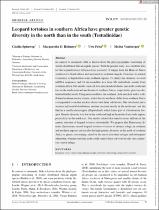| dc.contributor.author | Spitzweg, Cäcilia | |
| dc.contributor.author | Hofmeyr, Margaretha D. | |
| dc.contributor.author | Fritz, Uwe | |
| dc.contributor.author | Vamberger, Melita | |
| dc.date.accessioned | 2022-10-27T11:00:04Z | |
| dc.date.available | 2022-10-27T11:00:04Z | |
| dc.date.issued | 2018 | |
| dc.identifier.citation | Spitzweg, C., Hofmeyr, M.D., Fritz, U. and Vamberger, M., 2019. Leopard tortoises in southern Africa have greater genetic diversity in the north than in the south (Testudinidae). Zoologica Scripta, 48(1), pp.57-68. | en_US |
| dc.identifier.uri | https://doi.org/10.1111/zsc.12328 | |
| dc.identifier.uri | http://hdl.handle.net/10566/8082 | |
| dc.description.abstract | In contrast to mammals, little is known about the phylogeographic structuring of widely distributed African reptile species. With the present study, we contribute data for the leopard tortoise (Stigmochelys pardalis). It ranges from the Horn of Africa southward to South Africa and westwards to southern Angola. However, its natural occurrence is disputed for some southern regions. To clarify the situation, we used mtDNA sequences and 14 microsatellite loci from 204 individuals mainly from southern Africa. Our results retrieved five mitochondrial clades; one in the south and two in the north-west and north-east of southern Africa, respectively, plus two distributed further north. Using microsatellites, the southern clade matched with a well-defined southern nuclear cluster, whilst the two northern clades from southern Africa corresponded to another nuclear cluster with three subclusters. One subcluster had a western and central distribution, another occurred mostly in the north-east, and the third in a small eastern region (Maputaland), which forms part of a biodiversity hotspot. Genetic diversity was low in the south and high in the north of our study region, particularly in the north-east. Our results refuted that translocations influenced the genetic structure of leopard tortoises substantially. We propose that Pleistocene climatic fluctuations caused leopard tortoises to retract to distinct refugia in southern and northern regions and ascribe the high genetic diversity in the north of southern Africa to genetic structuring caused by the survival in three refuges and subsequent admixture, whereas tortoises in the south seem to have survived in only one continuous coastal refuge | en_US |
| dc.language.iso | en | en_US |
| dc.publisher | Wiley | en_US |
| dc.subject | Stigmochelys pardalis | en_US |
| dc.subject | Pleistocene | en_US |
| dc.subject | Maputaland | en_US |
| dc.subject | Horn of Africa | en_US |
| dc.subject | Africa | en_US |
| dc.title | Leopard tortoises in southern Africa have greater genetic diversity in the north than in the south (Testudinidae) | en_US |
| dc.type | Article | en_US |

